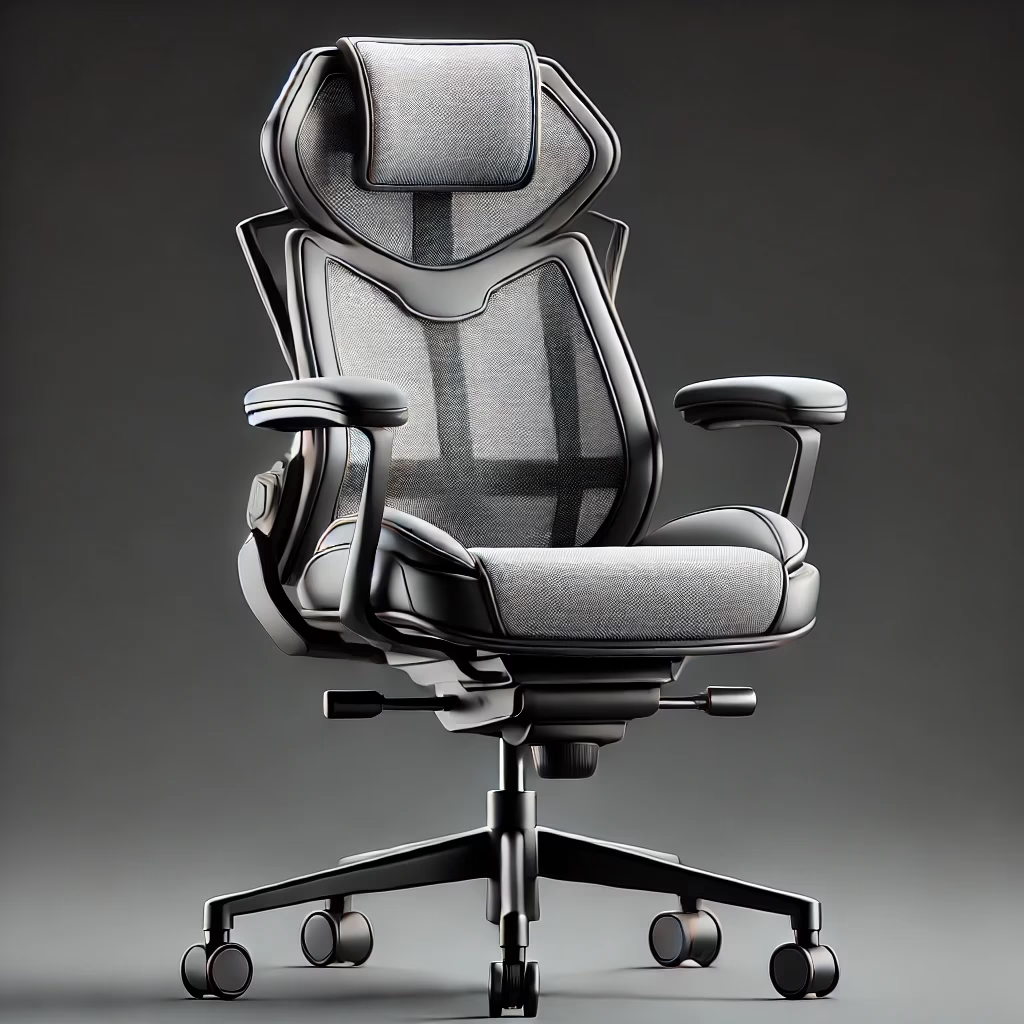The Ultimate Guide to Ergonomic Office Chairs: Supporting Posture and Reducing Strain During Long Working Hours
In today’s fast-paced work environment, many of us spend the majority of our day seated at a desk. Whether you’re working from home or in a traditional office setting, the importance of a good office chair cannot be overstated. An ergonomic office chair is specifically designed to support your posture, reduce strain, and enhance overall comfort during long working hours. In this comprehensive guide, we’ll explore the benefits of ergonomic office chairs, the science behind their design, and how to choose the right one for your needs.
What is an Ergonomic Office Chair?
An ergonomic office chair is a chair designed to support the natural curvature of the spine, promote good posture, and reduce the risk of musculoskeletal disorders (MSDs) associated with prolonged sitting. Unlike traditional office chairs, ergonomic chairs are adjustable, allowing users to customize the chair to fit their body type and work environment. Key features often include lumbar support, adjustable armrests, seat height and depth adjustments, and a reclining backrest.
The Importance of Ergonomics in the Workplace
Ergonomics is the science of designing products and environments to fit the people who use them. In the workplace, ergonomics aims to reduce physical strain and improve productivity by creating a comfortable and efficient work environment. Poor ergonomics can lead to a host of health issues, including back pain, neck strain, carpal tunnel syndrome, and even long-term musculoskeletal disorders.
According to a study published in the Journal of Occupational and Environmental Medicine, employees who used ergonomic office chairs reported a significant reduction in musculoskeletal discomfort and an improvement in overall productivity (Robertson et al., 2009). This highlights the importance of investing in ergonomic furniture, particularly for those who spend long hours at a desk.
The Science Behind Ergonomic Office Chairs
1. Lumbar Support: The Backbone of Comfort
One of the most critical features of an ergonomic office chair is lumbar support. The lumbar region of the spine (the lower back) has a natural inward curve, and sitting for extended periods without proper support can cause this curve to flatten, leading to poor posture and back pain.
A study published in Applied Ergonomics found that chairs with adjustable lumbar support significantly reduced lower back pain and improved posture among office workers (Vergara & Page, 2002). The study concluded that proper lumbar support helps maintain the natural curve of the spine, reducing strain on the lower back muscles.
2. Adjustable Armrests: Reducing Shoulder and Neck Strain
Armrests are another essential feature of ergonomic chairs. When typing or using a mouse, your arms should be supported to prevent strain on your shoulders and neck. Adjustable armrests allow you to position your arms at a comfortable height, reducing the risk of repetitive strain injuries (RSIs).
A study in the Journal of Electromyography and Kinesiology found that using armrests while typing significantly reduced muscle activity in the shoulders and neck, leading to less fatigue and discomfort (Szeto et al., 2005). This underscores the importance of adjustable armrests in an ergonomic office chair.
3. Seat Height and Depth: Promoting Proper Leg Alignment
The height and depth of the seat are crucial for maintaining proper leg alignment and reducing pressure on the thighs. A seat that is too high can cause your feet to dangle, leading to poor circulation, while a seat that is too low can cause your knees to bend at an awkward angle, putting strain on your hips and lower back.
A study published in Human Factors found that adjustable seat height and depth significantly improved comfort and reduced pressure on the thighs and buttocks (Hedge et al., 1999). The study recommended that office chairs should allow users to adjust the seat height so that their feet are flat on the floor and their knees are at a 90-degree angle.
4. Reclining Backrest: Encouraging Movement and Reducing Fatigue
A reclining backrest is another key feature of ergonomic office chairs. Sitting in a static position for long periods can lead to muscle fatigue and stiffness. A reclining backrest allows you to change your posture throughout the day, promoting movement and reducing the risk of fatigue.
Research published in Ergonomics found that chairs with a reclining backrest encouraged more frequent posture changes, which helped reduce muscle fatigue and improve comfort (O’Sullivan et al., 2012). The study concluded that a reclining backrest is an essential feature for preventing the negative effects of prolonged sitting.
Benefits of Using an Ergonomic Office Chair
1. Improved Posture
One of the most significant benefits of an ergonomic office chair is improved posture. By supporting the natural curves of the spine, ergonomic chairs help you maintain a neutral posture, reducing the risk of slouching or hunching over your desk. Good posture not only reduces strain on your muscles and joints but also promotes better breathing and circulation.
2. Reduced Risk of Musculoskeletal Disorders
Prolonged sitting in a poorly designed chair can lead to a range of musculoskeletal disorders, including back pain, neck strain, and carpal tunnel syndrome. Ergonomic chairs are designed to reduce the risk of these conditions by providing proper support and promoting healthy posture.
A study published in Spine found that office workers who used ergonomic chairs reported a significant reduction in back pain and musculoskeletal discomfort (Lis et al., 2007). The study concluded that ergonomic chairs are an effective intervention for reducing the risk of work-related musculoskeletal disorders.
3. Increased Productivity
Comfortable employees are more productive employees. When you’re not distracted by discomfort or pain, you can focus better on your work and maintain higher levels of productivity. Ergonomic chairs help reduce fatigue and discomfort, allowing you to work more efficiently.
A study in the Journal of Occupational and Environmental Medicine found that employees who used ergonomic office chairs reported higher levels of productivity and job satisfaction (Robertson et al., 2009). The study concluded that investing in ergonomic furniture is a cost-effective way to improve workplace productivity.
4. Enhanced Comfort
Comfort is perhaps the most immediate benefit of an ergonomic office chair. With features like adjustable lumbar support, armrests, and seat height, ergonomic chairs can be customized to fit your body and work environment, providing a comfortable seating experience throughout the day.

How to Choose the Right Ergonomic Office Chair
With so many options on the market, choosing the right ergonomic office chair can be overwhelming. Here are some key factors to consider when making your decision:
1. Adjustability
The best ergonomic chairs offer a high degree of adjustability, allowing you to customize the chair to fit your body and work environment. Look for chairs with adjustable lumbar support, armrests, seat height, and backrest recline.
2. Lumbar Support
As discussed earlier, lumbar support is crucial for maintaining good posture and reducing back pain. Choose a chair with adjustable lumbar support that fits the natural curve of your spine.
3. Seat Depth and Width
The seat should be deep and wide enough to support your thighs without putting pressure on the back of your knees. Look for chairs with adjustable seat depth to ensure a proper fit.
4. Material and Padding
The material and padding of the chair can affect your comfort level. Look for chairs with breathable, high-quality materials that provide adequate cushioning without being too soft or too firm.
5. Swivel and Casters
A chair with a swivel base and casters allows you to move around your workspace easily, reducing the need to twist or strain your body. Make sure the casters are suitable for your floor type (e.g., hard floor or carpet).
6. Warranty and Trial Period
Finally, consider the warranty and trial period offered by the manufacturer. A good ergonomic chair is an investment, and you’ll want to make sure you’re satisfied with your purchase. Look for chairs with a generous warranty and a trial period that allows you to test the chair in your own workspace.
Conclusion
An ergonomic office chair is more than just a comfortable place to sit—it’s a tool that can help you maintain good posture, reduce strain, and improve your overall health and productivity. By investing in a high-quality ergonomic chair, you can create a more comfortable and efficient work environment, whether you’re working from home or in a traditional office setting.
Remember, the best ergonomic chair is one that fits your body and work habits. Take the time to research and test different options to find the chair that’s right for you. Your body—and your productivity—will thank you.
References
- Robertson, M. M., Amick, B. C., DeRango, K., Rooney, T., Bazzani, L., Harrist, R., & Moore, A. (2009). The effects of an office ergonomics training and chair intervention on worker knowledge, behavior and musculoskeletal risk. Journal of Occupational and Environmental Medicine, 51(7), 759-771. Link
- Vergara, M., & Page, Á. (2002). Relationship between comfort and back posture and mobility in sitting-posture. Applied Ergonomics, 33(1), 1-8. Link
- Szeto, G. P., Straker, L., & Raine, S. (2005). A field comparison of neck and shoulder postures in symptomatic and asymptomatic office workers. Journal of Electromyography and Kinesiology, 15(1), 57-65. Link
- Hedge, A., McCrobie, D., Morimoto, S., Rodriguez, S., & Land, B. (1999). Effects of an ergonomic intervention on musculoskeletal discomfort among office workers. Human Factors, 41(4), 553-569. Link
- O’Sullivan, K., O’Sullivan, P., O’Sullivan, L., & Dankaerts, W. (2012). What do physiotherapists consider to be the best sitting spinal posture? Ergonomics, 55(4), 422-429. Link
- Lis, A. M., Black, K. M., Korn, H., & Nordin, M. (2007). Association between sitting and occupational LBP. Spine, 32(2), 263-270. Link








One Comment